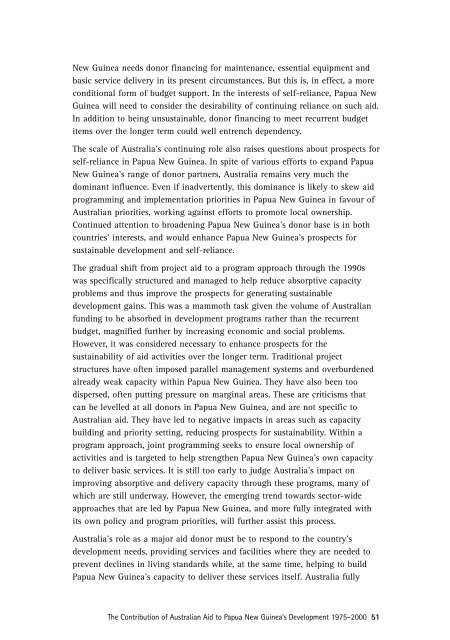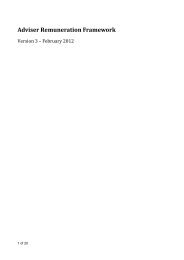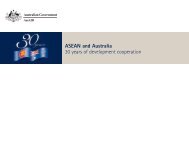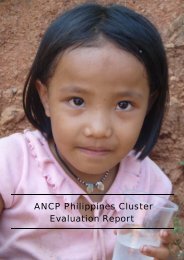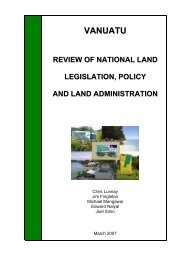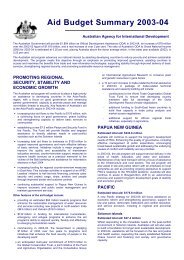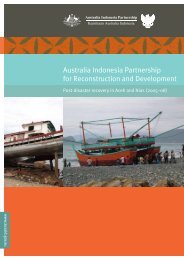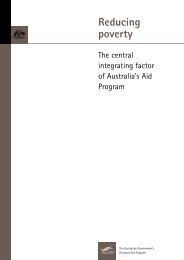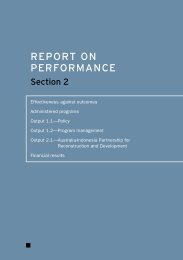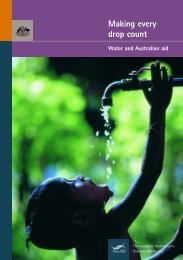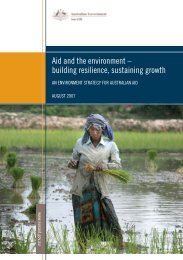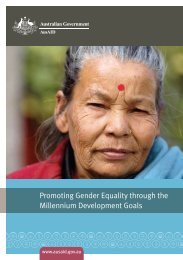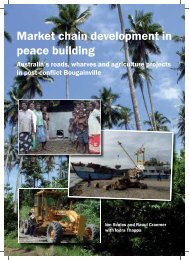Australian Aid to PNG - AusAID
Australian Aid to PNG - AusAID
Australian Aid to PNG - AusAID
You also want an ePaper? Increase the reach of your titles
YUMPU automatically turns print PDFs into web optimized ePapers that Google loves.
New Guinea needs donor financing for maintenance, essential equipment andbasic service delivery in its present circumstances. But this is, in effect, a moreconditional form of budget support. In the interests of self-reliance, Papua NewGuinea will need <strong>to</strong> consider the desirability of continuing reliance on such aid.In addition <strong>to</strong> being unsustainable, donor financing <strong>to</strong> meet recurrent budgetitems over the longer term could well entrench dependency.The scale of Australia’s continuing role also raises questions about prospects forself-reliance in Papua New Guinea. In spite of various efforts <strong>to</strong> expand PapuaNew Guinea’s range of donor partners, Australia remains very much thedominant influence. Even if inadvertently, this dominance is likely <strong>to</strong> skew aidprogramming and implementation priorities in Papua New Guinea in favour of<strong>Australian</strong> priorities, working against efforts <strong>to</strong> promote local ownership.Continued attention <strong>to</strong> broadening Papua New Guinea’s donor base is in bothcountries’ interests, and would enhance Papua New Guinea’s prospects forsustainable development and self-reliance.The gradual shift from project aid <strong>to</strong> a program approach through the 1990swas specifically structured and managed <strong>to</strong> help reduce absorptive capacityproblems and thus improve the prospects for generating sustainabledevelopment gains. This was a mammoth task given the volume of <strong>Australian</strong>funding <strong>to</strong> be absorbed in development programs rather than the recurrentbudget, magnified further by increasing economic and social problems.However, it was considered necessary <strong>to</strong> enhance prospects for thesustainability of aid activities over the longer term. Traditional projectstructures have often imposed parallel management systems and overburdenedalready weak capacity within Papua New Guinea. They have also been <strong>to</strong>odispersed, often putting pressure on marginal areas. These are criticisms thatcan be levelled at all donors in Papua New Guinea, and are not specific <strong>to</strong><strong>Australian</strong> aid. They have led <strong>to</strong> negative impacts in areas such as capacitybuilding and priority setting, reducing prospects for sustainability. Within aprogram approach, joint programming seeks <strong>to</strong> ensure local ownership ofactivities and is targeted <strong>to</strong> help strengthen Papua New Guinea’s own capacity<strong>to</strong> deliver basic services. It is still <strong>to</strong>o early <strong>to</strong> judge Australia’s impact onimproving absorptive and delivery capacity through these programs, many ofwhich are still underway. However, the emerging trend <strong>to</strong>wards sec<strong>to</strong>r-wideapproaches that are led by Papua New Guinea, and more fully integrated withits own policy and program priorities, will further assist this process.Australia’s role as a major aid donor must be <strong>to</strong> respond <strong>to</strong> the country’sdevelopment needs, providing services and facilities where they are needed <strong>to</strong>prevent declines in living standards while, at the same time, helping <strong>to</strong> buildPapua New Guinea’s capacity <strong>to</strong> deliver these services itself. Australia fullyThe Contribution of <strong>Australian</strong> <strong>Aid</strong> <strong>to</strong> Papua New Guinea’s Development 1975–2000 51


